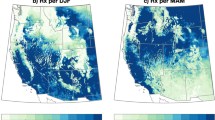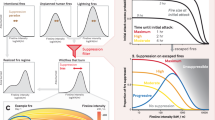Abstract
This study focused on how climate change-induced effects on weather will translate into changes in wildland fire severity and outcomes in California, particularly on the effectiveness of initial attack at limiting the number of fires that escape initial attack. The results indicate that subtle shifts in fire behavior of the sort that might be induced by the climate changes anticipated for the next century are of sufficient magnitude to generate an appreciable increase in the number of fires that escape initial attack. Such escapes are of considerable importance in wildland fire protection planning, given the high cost to society of a catastrophic escape like those experienced in recent decades in the Berkeley-Oakland, Santa Barbara, San Diego, or Los Angeles areas. However, at least for the three study areas considered, it would appear that relatively modest augmentations to existing firefighting resources might be sufficient to compensate for change-induced changes in wildland fire outcomes.
Similar content being viewed by others
References
California Department of Forestry and Fire Protection (CDF) (1992) FBDMOD: Fire behavior dispatch modeling system. Sacramento, California
Cayan D, Luers AL, Hanemann M, Franco G, Croes B (2006) Scenarios of climate change in California: An Overview (In review for same issue of Climatic Change)
Davis FW, Michaelsen J (1995) Sensitivity of fire regime in chaparral ecosystems to global climate change. In: Moreno JM, Oechel WC (eds) Global change and mediterranean-type ecosystems. Springer, New York, pp 435–456
Deeming JE, Burgan RE, Cohen JD (1977) The National Fire Danger Rating System 1978, General Technical Report INT-39, USDA Forest Service Intermountain Forest and Range Experiment Station, 63 pp.
Delworth TL, Broccoli AJ, Rosati A, Stouffer RJ et al (2006) GFDL’s CM2 global coupled climate models. Part 1: Formulation and simulation characteristics. J Clim 19(5):643–674
Fried JS, Gilless JK (1988) Stochastic representation of fire occurrence in a wildland fire protection model for California. For Sci 34:948–955
Fried JS, Gilless JK (1999) CFES2: The California Fire Economics Simulator Version 2 User’s Guide, University of California, Division of Agriculture and Natural Resources Publication 21580, 92 pp
Fried JS, Gilless JK, Spero J (2006a) Analysing initial attack on wildland fires using stochastic simulation. Int J Wildland Fire 15:137–146
Fried JS, Gilless JK, Riley WJ, Moody TJ, Simon de Blas C, Hayhoe K, Moritz M, Stephens S, Torn M (2006b) Predicting the effect of climate change on wildfire severity and outcomes in California: Preliminary analysis. California Climate Change Center White Paper CEC-500–2005–196-SF
Fried JS, Torn MS, Mills E (2004) The impact of climate change on wildfire severity: A regional forecast for Northern California. Clim Change 64:169–191
Gilless JK, Fried JS (1999) Stochastic representation of Fire Behavior in a Wildland Fire Protection Planning Model for California. For Sci 45:492–499
Hammer RB, Radeloff VC, Fried JS, Stewart SI (2007) Wildland–urban interface housing growth during the 1990s in California, Oregon, and Washington. Int J Wildland Fire 16:255–265
Lettman GJ, Azuma DL, Birch KR, Herstrom AA, Kline JD (2004) Land use change on non-federal land in eastern Oregon, 1975–2001. Salem, OR: Oregon Department of Forestry. 42 p
Nakićenović N, Alcamo J, Davis G, de Vries B, Fenhann J, Gaffin S, Gregory K, Grübler A, Jung TY, Kram T et al (2000) IPCC special report on emissions scenarios. Cambridge University Press, Cambridge, United Kingdom and New York, New York
National Wildfire Coordinating Group (NWCG) (2002) Gaining and Understanding of the National Fire Danger Rating System. Publication PMS 932, NFES 2665.
Torn MS, Fried JS (1992) Predicting the impacts of global warming on wildland fire. Clim Change 21(3):257–274
Van Rheenen NT, Wood AW, Palmer RN, Lettenmaier DP (2004) Potential implications of PCM climate change scenarios for California hydrology and water resources. Clim Change 62:257–281
Washington WM, Weatherly JW, Meehl GA, Semtner AJ, Bettge TW, Craig AP, Strand WG, Arblaster J, Wayland VB, James R, Zhang Y (2000) Parallel climate model (PCM) control and transient simulations. Clim Dyn 16:755–774
Wood AW, Maurer EP, Kumar A, Lettenmaier DP (2002) Long range experimental hydrologic forecasting for the eastern U.S. J Geophys Res 107(D20):4429
Author information
Authors and Affiliations
Corresponding author
Rights and permissions
About this article
Cite this article
Fried, J.S., Gilless, J.K., Riley, W.J. et al. Predicting the effect of climate change on wildfire behavior and initial attack success. Climatic Change 87 (Suppl 1), 251–264 (2008). https://doi.org/10.1007/s10584-007-9360-2
Received:
Accepted:
Published:
Issue Date:
DOI: https://doi.org/10.1007/s10584-007-9360-2




